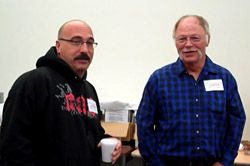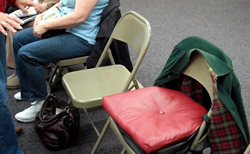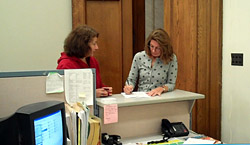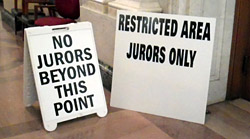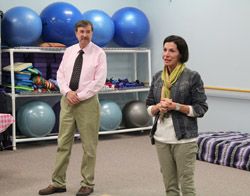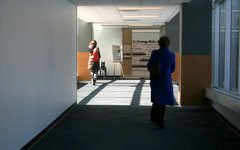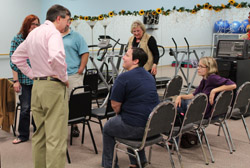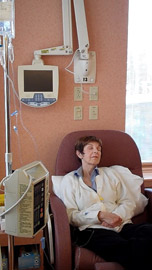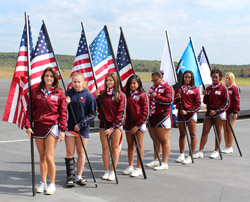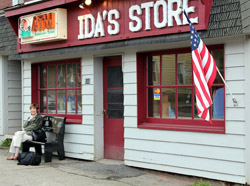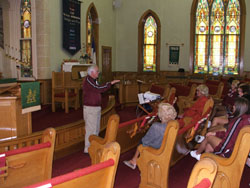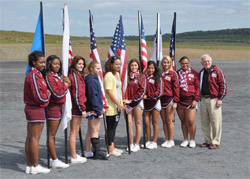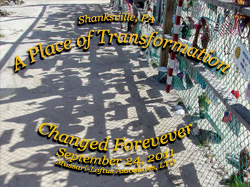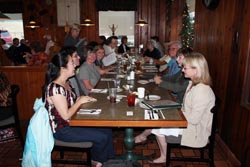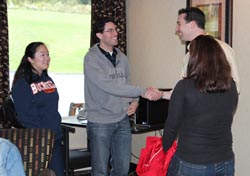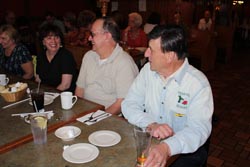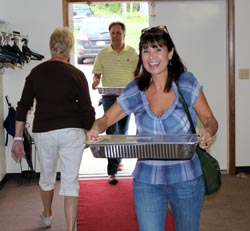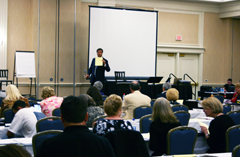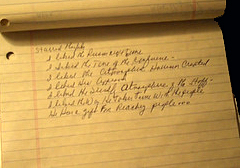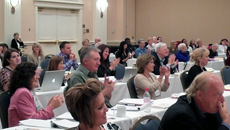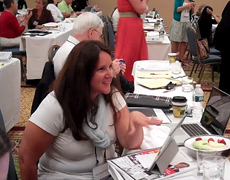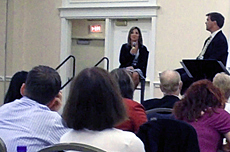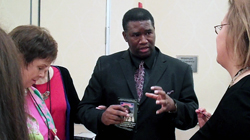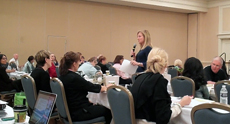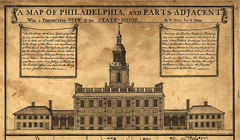15 Hours in Catonsville, Maryland
By Tony Mussari, Sr.
Copyright 2011
Mussari-Loftus Associates, LTD
We realized that the important thing was not the film itself but that which the film provoked. Fernando Solanas
While driving to Catonsville, Maryland on a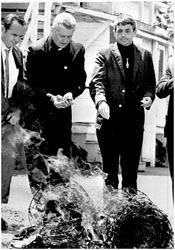 beautiful October morning, a story from half a lifetime ago flashed through my mind. It’s the only thing I know about Catonsville.
beautiful October morning, a story from half a lifetime ago flashed through my mind. It’s the only thing I know about Catonsville.
On May 17, 1968, nine people, including two Catholic priests and a Christian Brother, went to the Selective Service office in Catonsville to destroy draft documents. They filled two wire baskets with stolen documents. Then, they assembled in a parking lot where they burned the documents to protest the Vietnam War.
Their act of civil disobedience was headline news all over the country. Four months later they went on trial in Baltimore, and the rest as they say is history.
Fast forward 33 years. It’s October 5, 2011, the anniversary of the trial of the Catonsville 9. On this day, the morning papers are filled with stories of protesters carrying signs heralding “The 99” and their protest against corporate greed. The first amendment is alive and well in America.
On this day my head and my heart were filled with anticipation. I was going to Catonsville to screen and discuss our documentary, Shanksville, PA: A Place of Transformation. It was a very special occasion, because the invitation came from a former student, now a successful manager and part time teacher, Dr. Richard Ostopowicz.
Rick, as he likes to be called and I have a history. We met at a time and place when we had some teaching moments. They were not comfortable or easy moments, but they were transformational moments for Rick. He graciously acknowledges their importance in his education and development. His old teacher relishes in his success.
Someone once told me a teacher must do everything he can to see to it that the student has an opportunity to equal and surpasses the achievements of the teacher. Sometimes it is affirmation, and other times it’s candor. To use the words of Steve Jobs, “at one time in our life all of us will be hit in the head with a brick.” Teachers use softer language, but the consequence is the same. People with a learning, not a sulking, disposition understand it is one of the best things that can ever happen. It produces transformations.
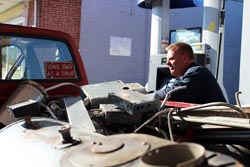
When I arrived in Catonsville, I had two experiences that endeared me to the city. I stopped at Edmondson Sunoco. As I finished filling my Prius, a red truck carrying discarded metal parts pulled into the station. My eyes scanned the scene and settled on a sign attached to the rear window. It read, “One Day at a time.”
I was curious and intrigued; the why question motivated me to get my digital camera. I approach the driver, and I asked him for permission to take a picture of the sign.
He obliged.
When I finished, I had a brief conversation with Bill Garry about his sign, and I discovered the heart and soul of a man with a beautiful smile and a wonderful disposition.
“Living life one day at a time is central to the AA program,” he told me. “I try to live these words every day.”
The expression on Bill’s face spoke volumes about the man and his life. It is a moment I will never forget.
Shortly after I left the Sunoco station, I managed to get lost. I ended up in the parking lot of Pierce Cleaners and Tuxedo. Once inside I met Kyle Davis the owner of Edwards Home and Lawn. He volunteered to help me find my destination. Using his smart phone he found the address. It just happened to be in the shadow of the parking lot two blocks away.
managed to get lost. I ended up in the parking lot of Pierce Cleaners and Tuxedo. Once inside I met Kyle Davis the owner of Edwards Home and Lawn. He volunteered to help me find my destination. Using his smart phone he found the address. It just happened to be in the shadow of the parking lot two blocks away.
My two person survey of Catonsville left a positive impression of the town and its residents, not scientific to be sure, but heartwarming nonetheless.
As I was getting out of my car in front of Rick’s home, I had another serendipitous moment. A white pickup truck pulled in behind me, and a warm voice spoke words of welcome that sealed the deal. This would be a very good visit.

After dinner with Rick, his wife and their two adorable boys, we were off to the community college for the main event.
The ride to the Catonsville Campus of the Community College of Baltimore was short, and the conversation during the ride was pleasant. When we entered the building, I felt the rush of pre-class anxiety and expectation. I could feel myself going into teacher mode.
Rick is a big man with a very engaging manner. He attended to the technology making sure that everything was in place to optimize the screening for everyone who attended. While he talked with students, I printed a structural outline for the class on a chalkboard next to the entrance to the room. As students took their seats I visited with them to introduce myself, and I suggested that they take a seat in the center of the room where they would get the best view of the documentary.
Rick picked up on this, and he projected a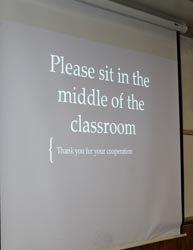 typewritten sign that reinforced my suggestion.
typewritten sign that reinforced my suggestion.
When all of the students were assembled, Rick collected their assignments. He shared some refinements for matters discussed in the previous class, and then he gave me the floor.
After I reviewed the outline for the class, I asked everyone to disconnect from their digital devices, and I repeated words I received earlier in the day in an e-mail from a former student who is a successful corporate executive in Florida. “Push the pause button.” I implored the students to focus their attention on what would happen in their classroom for the next three hours. The students who were in the room turned off their smart phones.
To provide context for the film, I read excerpts from the introduction I presented in Shanksville on September 24. Two key points were emphasized:
Ten years ago, we made a promised to tell the Shanksville story with dignity and class. For 3,650 days, we have remained true to that promise. In doing that, we have been changed in ways we never thought possible.
Today, Kitch and I look at our county through a different lens, and we measure ourselves and the people we meet against the Shanksville standard.
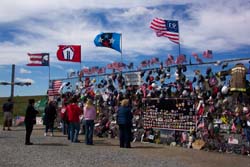
We produced Shanksville, PA: A Place of Transformation, the 22d episode in our What Is America? series, to remember the heroes of Flight 93, to put the spotlight of affirmation on a group of students who speak eloquently and convincingly about their county, this place of hope and healing, and the America dream.
Yesterday we celebrated the heroes of the day the earth stood still for America. Today we come together as a community of people searching for answers to questions that are larger than life. Tonight we will remember the legacy of yesterday to guarantee the promise of tomorrow.
At 8:05 p.m., four hours after I arrived in Catonsville, the lights were dimmed and the screening began.
I selected a seat in the back of the room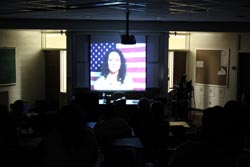 where I could see the audience as well as the film. I was impressed by the quite attentiveness of the students during the film. There was but one distraction. A student who arrived late settled in a seat next to mine. Before he sat down, we shook hands and I welcomed him. He was very pleasant and respectful. Unfortunately, he did not hear the request to push the pause button and detach from digital devices. At critical points in the film his eyes were on his smart phone. At one important point before the end of the film, I asked him to put his eyes on the screen. He politely turned off the phone, and he watched the ending.
where I could see the audience as well as the film. I was impressed by the quite attentiveness of the students during the film. There was but one distraction. A student who arrived late settled in a seat next to mine. Before he sat down, we shook hands and I welcomed him. He was very pleasant and respectful. Unfortunately, he did not hear the request to push the pause button and detach from digital devices. At critical points in the film his eyes were on his smart phone. At one important point before the end of the film, I asked him to put his eyes on the screen. He politely turned off the phone, and he watched the ending.
Shortly after 9 p.m., the credits rolled. Then, the lights came on. Rick gave the students a short break. When they returned, the discussion began.
Several students liked the positive tone of the documentary. They liked the comments of the people featured in the film, especially the Cheerleaders from North Plainfield High School in New Jersey. One person called them genuine. Another person said she liked the story and the way it was presented.

From the back of the room, I received a warm greeting. “I’m from Duryea in Northeastern Pennsylvania. I like the film.” This special moment produced a spontaneous response from Rick. “Why does it take a visiting professor from 200 miles away to let me know I am teaching a student who was born and raised where I grew up?”
Another person admitted that she rarely thinks about the significance of 9/11 and Shanksville. The documentary helped her to better understand the need to think more about the events of that day and its consequences for her generation.
One student had very complimentary things to say about the documentary and this genre of film making. “You told us your intention was to entertain and inform us,” she said. “You did that tonight.”
Another student liked the musical selections in the film.
Not all of the feedback was positive. One student made a hard landing on a metaphor used by one of the speakers in the film. Another student who lost a nephew on 9/11 expected more first person stories told by survivors.
student made a hard landing on a metaphor used by one of the speakers in the film. Another student who lost a nephew on 9/11 expected more first person stories told by survivors.
The most earthy interpretation came from one of the last people to comment. He used strong language to express the anger he was feeling. He needed time to think and sort things out. “I won’t be able to tell you what I think until 8:30 tomorrow morning,” he said.
When I told him this was the highest compliment any documentary filmmaker could receive. He pushed himself back in his seat. His eyes opened wide, and a look of pleasant surprise covered his face.
If truth be told, documentary is all about evoking emotions and deeply felt reactions. If what is on the screen makes someone think, that’s about as good as it gets.

At 10:20 p.m., I asked the students and their teacher, Dr. Rick Ostopowicz, to assemble in the front of the room for a surprise. Then, I presented the National 9/11 Remembrance Flag to them for their school. Watching the smiles of satisfaction on their faces as they posed for a group picture is a frozen frame I will always remember from this visit.
Before we said our good byes, I asked the students to participate in an exercise I learned from my friend Professor George Parks at the University of Massachusetts. It was designed to help them identify their personal best.
The exercise worked, and the evening ended on a very positive note.
I spent the night in Rick’s guest room. Early the next morning we talked for a bit, made some plans for future visits, and then at 7:15 a.m. I headed home with a hundred different memories of the visit, the students, their teacher and the screening carefully stored in the safe deposit box of my soul.
As I drove north watching the traffic jams as thousands of people headed for Baltimore, I thought to myself how fortunate I was to be Rick’s teacher and friend, and how good it felt to be a visiting teacher in his classroom.
Before I knew it, I was sitting in traffic on a congested part of Rt.15 in Harrisburg. On this morning of reflection, I didn’t mind the delays. Eventually, I was back on the open road taking in the sun drenched scenery of the rural landscape of the Keystone state, and thinking about the 15 hours I spent in Catonsville.
Then it happened.
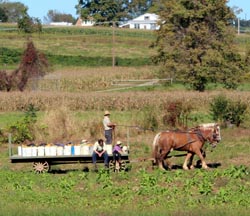
I spotted an Amish farmer making his way on a wagon pulled by two horses. I stopped the car on the side of the road, and I took some pictures. For me, the pictures recorded a perfect end to a perfect trip. It helped to put everything in perspective.
In Shanksville, I met people who wanted to preserve the legacy of an important moment in our history.
In North Plainfield, New Jersey, I worked with students who went to Shanksville. While they were there, they discovered what it means to be an American.
In Catonsville, Maryland, the students and I were able to exercise our first amendment rights to assemble, learn and express our opinions without fear of reprisal.

On the farm bordering a blue lined road in Pennsylvania, two Amish men, two Amish children, their spotted dog, two horses and 72 containers of freshly picked carrots, spoke to America at its best. This compelling image tells us that ours is a country where everyone has a right to be who they are, do what you do, worship the God of their choice and feel the warm spirit of belonging.
Collectively, the images from my 15 hours in Catonsville prove beyond any question the validity of Dr. Stephen Post’s words: “America is the land of the free and the home of the good.”
They give truth to the advice of Steve Jobs, “The only way to do great work is to love what you do.”
I don’t know if I did great work in Catonsville. That’s for someone else to decide, but I do know I love being an old teacher in a new classroom.
Thank you Flight 93 for your valor.
Thank you, Dr. Rick Ostopowicz for the opportunity.
Thank you, students from the Community College of Baltimore for your time and attention.
Thank you, North Plainfield Cheerleaders for your thoughtful stories,
Thank you, America. We are blessed to be your citizens.
(Picture of the Catonsville 9 protest, modernhistorian.blogspot.com; picture of the Peoples’ Memorial in Shanksville, Kitch Mussari; picture of the Permament memorial in Shanksville, Frank Pizzani; all other pictures Tony Mussari, Sr.)
Please provide feedback to:
tmussari@gmail.com
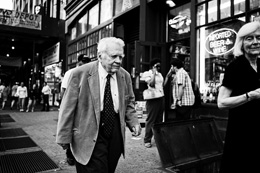 thinking about death of another kind. That’s a story for another day.
thinking about death of another kind. That’s a story for another day.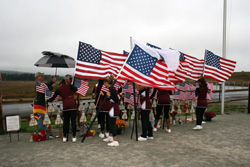
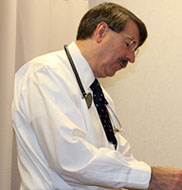

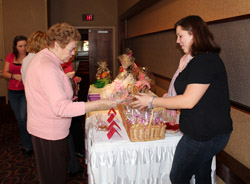
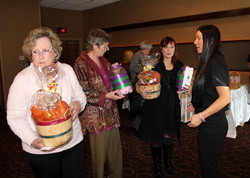

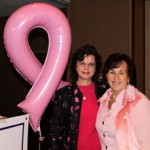
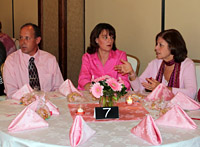
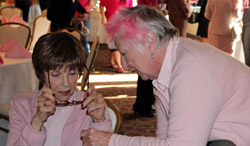
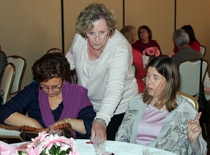

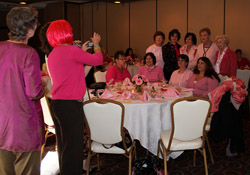
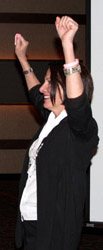


![images[3]](http://faceofamericawps.com/wp-content/uploads/2011/10/images3.jpg)

